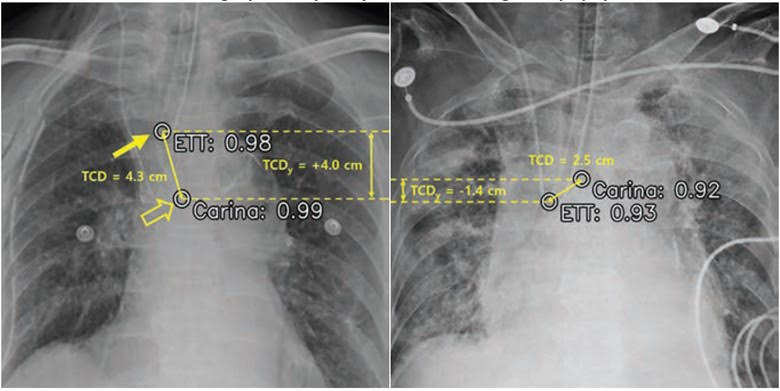AI Identifies Improperly Positioned Endotracheal Tube Using Chest Radiographs
Images

An artificial intelligence (AI) system developed by Lunit (Seoul, Korea) identified improperly positioned endotracheal tube (ETTs) on chest radiographs obtained after ETT insertion, as well as on chest radiographs obtained from patients in the ICU at two institutions, according to an article published in the American Journal of Roentgenology (AJR).
“Automated AI identification of improper ETT position on chest radiograph may allow earlier repositioning and thereby reduce complications,” wrote corresponding author Eui Jin Hwang, MD, PhD, from the department of radiology at Korea’s Seoul National University Hospital.
Hwang et al.’s retrospective AJR study included 539 chest radiographs obtained immediately after ETT insertion from January 1, 2020 to March 31, 2020 in 505 patients (293 men, 212 women; mean age, 63 years) from institution A (sample A); 637 chest radiographs obtained from January 1, 2020 to January 3, 2020 in 304 patients (158 men, 147 women; mean age, 63 years) in the ICU (with or without an ETT) from institution A (sample B); and 546 chest radiographs obtained from January 1, 2020 to January 20, 2020 in 83 patients (54 men, 29 women; mean age, 70 years) in the ICU (with or without an ETT) from institution B (sample C). Lunit’s commercial DL-based AI system was used to identify ETT presence and measure ETT tip-to-carina distance (TCD). Reference standard for proper ETT position was TCD between 3 cm and 7 cm, determined by human readers. Critical ETT position was separately defined as ETT tip below the carina or TCD less than or equal to 1 cm.
Ultimately, in three patient samples from two different institutions, an AI system identified ETT presence with sensitivity of 99.2–100%; and specificity of 94.5–98.7%, improper ETT position with sensitivity of 72.5–83.7% and specificity of 92.0–100%, and critical ETT position with sensitivity of 100% in all samples and specificity of 96.7–100%.
Related Articles
Citation
. AI Identifies Improperly Positioned Endotracheal Tube Using Chest Radiographs. Appl Radiol.
September 15, 2023